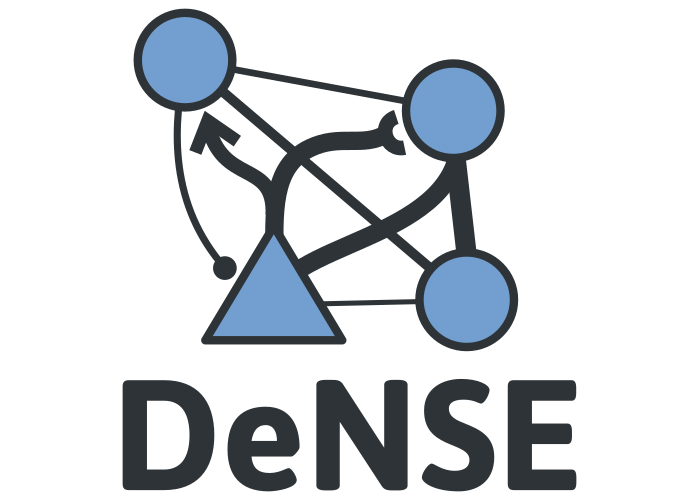Direction selection component¶
The way the growth cone navigates its environment is determine in DeNSE by growth models composed of three components: on accounting for the extension component, the second accounting for steering, and the last, the direction selection component, being responsible for the final angular of the current step.
This last component takes the probability for each direction computed by the steering component and picks one of the directions from this set of probabilies.
Together with the steering component, the direction selection is responsible for a central property of neurites, which is their persistence length (\(l_p\)), a simple measure of length characterizing the distance over which the neurite can be approximated by a straight rod. As such, this is often the parameter that users might want to set for their model, instead of setting other parameters which have a less direct biological interpretation.
For a persistence length \(l_p\), the correlation between the directions
The selection algorithms implemented in DeNSE are listed below, and the relation between the percise parameters and the persistence length is detailed here for each model:
Noisy maximum¶
This algorithm simply selects the angle associated to the maximum value of the probability list, then applies a random shift of this angle to obtain the final angle.
with \(\xi \in \mathcal{N}(0, \sigma)\) a normal random variable.
Thus, the parameters that can be set for this model are either:
noise_amplitude(\(\sigma\)), to directly set the jitter on the angle,or
persistence_length(\(l_p\)), so that DeNSE will automatically set the value ofnoise_amplitudeto obtain the requested persistence length.
If the persistence_length parameter is set, then the noise_amplitude
\(\sigma\) is automatically computed as:
where \(v\) is the current growth cone speed and \(dt\) is the current timestep.
This model is used in the netmorph-like model to reproduce the scheme that
was implemented in the NETMORPH simulator [Koene2009].
Note
If all probabilities are equal, DeNSE will automatically choose the angle closest to the current direction.
Noisy weighted average¶
This scheme choses the angle for the current step as the average of the available angles weighted by their respective probabilities, with the subsequent addition of a random noise on the angle:
As for the previous scheme, the parameters that can be set for this model are either:
noise_amplitude(\(\sigma\)), to directly set the jitter on the angle,or
persistence_length(\(l_p\)), so that DeNSE will automatically set the value ofnoise_amplitudeto obtain the requested persistence length.
As for the noisy maximum, gf the persistence_length parameter is set, then
the noise_amplitude \(\sigma\) is automatically computed as:
where \(v\) is the current growth cone speed and \(dt\) is the current timestep.
This algorithm is notably used in the simple-random-walk and
self-referential-forces models as it reproduces the vector addition of
forces in these models.
Run-and-tumble¶
The run-and-tumble model is a well-known biophysical model with low computational cost and a rather straightforward definition of the persistence length, which was initially used to model the displacement of bacteria in solutions.
In this algorithm the growth cone elongates over a certain distance in a straight line, before turning suddently in a new direction. This new angle follows a uniform distribution centered around the previous direction, and spanning the sensing angle \(\theta_s\).
The “tumbling” events, at which the direction changes, follow an exponential distribution which depends on the distance done with a characteristic length \(l_r\), which is the average length of a “run”.
To obtain the correct persistence length, the three variables must obey the equality:
The parameters which can be set for the run-and-tumble model are therefore either:
the
persistence_length(\(l_p\)),or the
run_length\(l_r\).
Of course, the sensing_angle also appears in the equation and is technically
a parameter of the model, but it is not specific to the model since it is a
general parameter for growth cones and also influences all spatial interactions.
References¶
- Hjorth2014
Hjorth, Van Pelt, Mansvelder & Van Ooyen (2014). Competitive dynamics during resource-driven neurite outgrowth. PLoS One, 9.
- Koene2009
Koene, Tijms, van Hees, Postma, de Ridder, Ramakers, van Pelt, & van Ooyen (2009). NETMORPH: a framework for the stochastic generation of large scale neuronal networks with realistic neuron morphologies. Neuroinformatics, 7(3), 195–210. https://doi.org/10.1007/s12021-009-9052-3
- Memelli2013
Memelli, Torben-Nielsen, & Kozloski (2013). Self-referential forces are sufficient to explain different dendritic morphologies. Front. Neuroinform. 7, 1.
